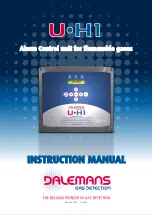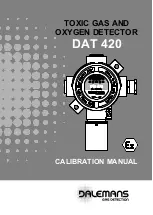
5
Bushings
Hexagon screws 3mm
Status LED
„ALARM“
Status LED
„POWER“
Status LED
„ERROR“
Sensor module
Mounting holes
PCB electronics
Jumper connector of
the terminating
resistor RS485
Terminal block RS485 B
Terminal block RS485
A
4-20mA signal terminal
block
GND power supply
terminal block
DIP switch for the
RS485 adress
+24V DC Power
supply terminal block
Assembly and disassembly of the transmitter
Before assembling, read the valid instalation standarts EN 60079-29-2 (Selection, instalation, use and maintenance of
detectors for combustible gases and oxygen) and EN 45544-4 (Guildelines for the selection, installation, use and maintenance
of detectors of toxic substances).
Secure that the sensor is reachable by air. The transmitter must be in a free area with no obstacles in its way (furniture etc.)
Ensure that the input of the sensor cannot be polluted by layers of dust or other contamination.
To maintain IP protection the
transmitter must be assambled with the sensor module facing downwards
.
1.
Assembly of the transmitter
The transmitter consists of four parts - the body of the transmitter, the removable sensor and bushings.
Transmitter assembly procedure is as follows:
a)
Disassemble the transmitter with the four hexagon socket screws 3mm
b)
Use a screwdriver to break out holes for the bushings
c)
Mount the transmitter on a flat surface with four 6mm fasteners in height above the floor with the gas entrance
facing downwards, as specified by the detected substance
d)
Direct the cable trough the bushings
e)
Connect the wiring to the terminal block according to " Installation of wiring for RS485".
f)
Assemble the transmitter with the four hexagon sockets scews 4mm
2.
Replacement of the sensor module
This activity must not be performed when the sensor is energized.
In case of need to replace the sensor module with a new piece, unscrew and remove the
cover. Unscrew the two 3mm hexagon screws and take out the sensor module by applying
pressure with a tool from the inside. Carefully insert the new sensor module - be careful not
to bend the pins! Screw the two 3mm hexagons screws and put back the cover. Screw the
cover.
3.
Connecting the transmitter via current loop to the controler DEGA UPA IIDEGA UPA III a DEGA UDA III
Connect one transmitter to each channel of the controler as shown in the picture below
1
2
3
4
5
6
7
8
1
2
3
4
5
6
7































